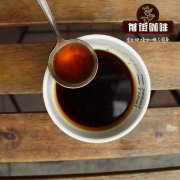What are the characteristics of mocha coffee beans in Yemen? Yemeni Coffee the planting history of Yemeni mocha coffee

Professional coffee knowledge exchange more coffee bean information please follow the coffee workshop (Wechat official account cafe_style)
In 1708, de la Roque and three ships from the French East India Company arrived at the port of Mocha in Yemen, becoming the first French to sail around the southern tip of Africa into the Red Sea. At the risk, they spent a year sailing such a long distance just to buy coffee directly.
Coffee has long been associated with Latin America, but for about 300 years (half of the time since coffee was a commodity), Arabs monopolized the sale of Arabica coffee. What annoys the French most is that the middlemen in the coffee trade are mostly Arabs, Egyptians and Indians. But it won't last long, and Europeans will eventually sweep the coffee trade, making the history of Yemen's exclusive coffee trade a faint and distorted memory, and de la Roque is one of the important drivers of this wave.
Arabica coffee trees are native to Ethiopia, but coffee drinks were developed in the Yemeni city of Moka around 1400. By 1500, the drink had been found everywhere in the Arabian Peninsula.
The special envoy of the Ottoman Sultan, who arrived in France and Austria from 1665 to 1666, prepared many of these rare drinks at luxurious parties, thus enhancing the function of coffee in promoting interpersonal communication and status in Europe. The Turks also inadvertently contributed to the popularity of coffee drinks in Europe. In 1683, the Turks besieged Vienna for a long time and finally withdrew their troops, leaving behind some coffee bags. Later, the owner of the first cafe in Vienna thought of filtering out the sediment of Turkish coffee and adding honey and milk to make coffee more acceptable to Europeans. But Arabica coffee is still a very rare specialty at this time.
Because coffee is expensive. Yemeni manual production, layers of exploitation by middlemen and high transportation costs make coffee almost a luxury. Before 1690, only Yemeni coffee was grown in three coffee-producing areas, located on steep, irrigated hills divided into small coffee plantations with only a few hundred farmers.
Farmers bring their own coffee beans from a nearby small coffee garden to the market to sell them all the year round. De la Roque recorded that the harvest was "irregular and irregular, so the Arabs did not know that there was a so-called harvest season". Coffee farmers bring coffee beans to the market six days a week and sell a little more coffee every day than they did the day before; when the price is low, they do not sell it. In the market, Indian businessmen and Arabs control the coffee business. The Dutch and British East India companies have had representatives in Mocha since the early 17th century, and even so, they, like de la Roque, are bought through Indian middlemen who are said to be the best bargainers. Europeans have a low commercial status because they have no political clout, and the only European goods the Yemenis want is Piast coins made of Mexican silver, which they need on the spot.
Encouraged by the results of the voyage, de la Roque returned to Mocha two years later. This time he visited the king of Yemen and found that the king had planted a large coffee tree. The Frenchman criticized the king of Yemen, explaining that the king of Europe only grows ornamental plants in the royal botanical garden.
Later, de la Roque greatly regretted this discussion, because when he returned to Paris, he found that his description of Louis XIV's Royal Botanical Garden was wrong. The trader said at the end of his adventure report: "the most appropriate and appropriate conclusion of this report is to mention."... The coffee tree finally came from Holland. "
The coffee tree planted in the Sun King Louis XIV Botanical Garden is a witness to the European colonization of America. Its seeds were taken to the other side of the Atlantic, and it became the ancestor of many coffee trees in America. The French have found a way to break the Arab monopoly on the coffee trade. In less than 50 years, coffee produced on the Latin American island of Martinique (a French colony) gradually replaced mocha in the Cairo market. Yemen can't beat the mass production of the colonies. In 1900, Yemen produced less than 1% of the world's coffee beans, and Mocha's glorious history of 300 years of dominating the global coffee market can now be brought back only by a special drink made with chocolate mixed with coffee from America.
YEMEN MOCHA, Yemen, although, in terms of species research, coffee originated from Ethiopia, from a humanistic point of view, the introduction of coffee as a beverage to the European world took place in Yemen in Arabia. since then, coffee is equal to Yemen and Mocha.
Mocha is a commercial port, just as Brazilian coffee is exported by Santos port, so it is called Brazilian coffee with Santos. The port of Mocha, which exports coffee, has also become the general name of Yemeni coffee.
Qianjie Coffee suggests [Yemeni mocha] brewing parameters:
V60According to one minute and fifty seconds, 15 ℃ / time
Flavor: spices, chocolates, grapes
Important Notice :
前街咖啡 FrontStreet Coffee has moved to new addredd:
FrontStreet Coffee Address: 315,Donghua East Road,GuangZhou
Tel:020 38364473
- Prev

What are Yemeni classic coffee beans? How do you drink Yemeni coffee? Is the Yemeni mocha coffee good?
Professional coffee knowledge exchange more coffee bean information Please follow the coffee workshop (official Wechat account cafe_style) although the wave of boutique is the revival of technology replacing machinery, but the dominant supply and demand is still inseparable from the market
- Next

What are the boutique coffee beans of Yemeni coffee? Yemeni famous coffee beans
Professional coffee knowledge exchange more coffee bean information please follow the coffee workshop (Wechat official account cafe_style) Yemen mocha (YEMEN MOCHA), although in terms of species research, coffee originated in Ethiopia, but from a human point of view, the introduction of coffee as a beverage to the European world took place in Yemen, Arabia, and there has been a period since then.
Related
- Detailed explanation of Jadeite planting Land in Panamanian Jadeite Manor introduction to the grading system of Jadeite competitive bidding, Red bid, Green bid and Rose Summer
- Story of Coffee planting in Brenka region of Costa Rica Stonehenge Manor anaerobic heavy honey treatment of flavor mouth
- What's on the barrel of Blue Mountain Coffee beans?
- Can American coffee also pull flowers? How to use hot American style to pull out a good-looking pattern?
- Can you make a cold extract with coffee beans? What is the right proportion for cold-extracted coffee formula?
- Indonesian PWN Gold Mandrine Coffee Origin Features Flavor How to Chong? Mandolin coffee is American.
- A brief introduction to the flavor characteristics of Brazilian yellow bourbon coffee beans
- What is the effect of different water quality on the flavor of cold-extracted coffee? What kind of water is best for brewing coffee?
- Why do you think of Rose Summer whenever you mention Panamanian coffee?
- Introduction to the characteristics of authentic blue mountain coffee bean producing areas? What is the CIB Coffee Authority in Jamaica?

